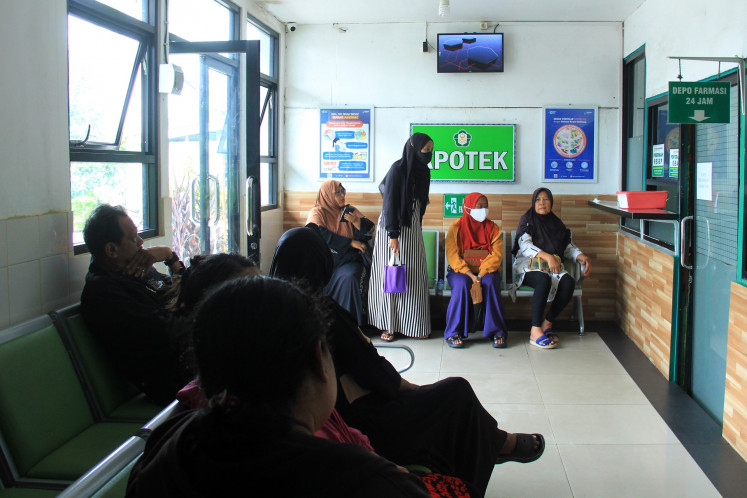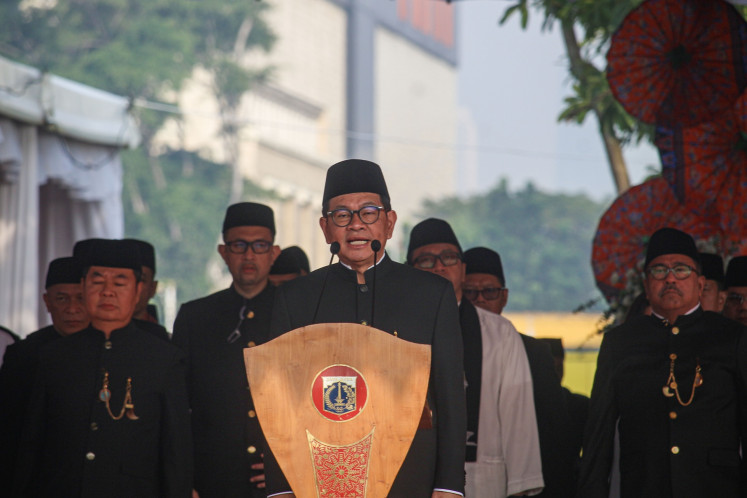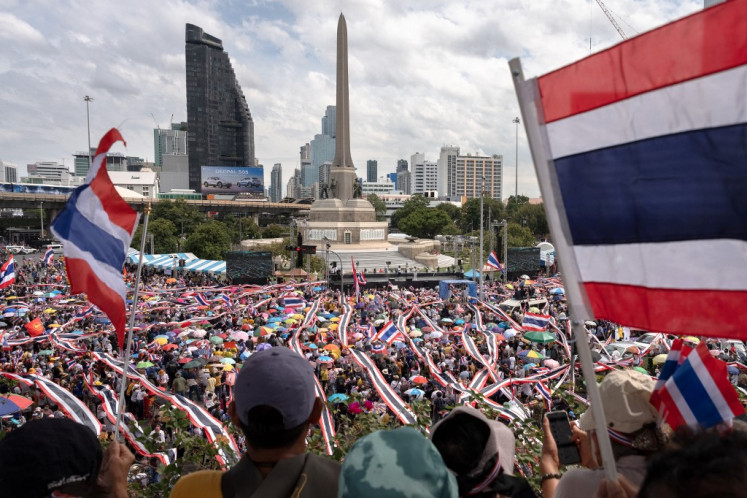Popular Reads
Top Results
Can't find what you're looking for?
View all search resultsPopular Reads
Top Results
Can't find what you're looking for?
View all search resultsIndonesia-India ties: A change in the wind?
Through this G2G deal, the Indonesian government is eyeing the import of 1 million tons of rice from India per year for the next four years. Currently, the deal is in the final stages, and is expected to be signed in the next few months.
Change text size
Gift Premium Articles
to Anyone
 Indian movies, TV serials and even Bollywood actors like Shah Rukh Khan have become household names in Indonesia. Many channels are now showcasing Indian content dubbed in Indonesian, clearly indicating that the love for Indian entertainment is only expected to grow more. (AP/ Kamran Jebreili)
Indian movies, TV serials and even Bollywood actors like Shah Rukh Khan have become household names in Indonesia. Many channels are now showcasing Indian content dubbed in Indonesian, clearly indicating that the love for Indian entertainment is only expected to grow more. (AP/ Kamran Jebreili)
P
resident Joko “Jokowi” Widodo’s recent revocation of a meat ban, which provided new encouragement for supporters of more relaxed regulation of rice and pharmaceutical imports, has directed attention once again to the vast potential of trade and investment that remains dormant between India and Indonesia.
Allowing bovine meat to be imported from regions free of foot and mouth disease, regardless of a country’s status overall, comes as a big positive for countries like India, which has been eyeing the Indonesian market since 1999.
An Indonesian high-level delegation visited India in September 2015 to evaluate meat processing facilities and food safety measures there. After extensive evaluation and examination, the Indonesian government has allowed region-based meat import permits for Indian suppliers, formalized in a decree that was signed recently.
This announcement has created a frenzy among traders, for whom this is a potential game changer. With Ramadan also around the corner, many are hopeful that this new rule will end price fluctuations and ensure greater certainty for meat prices in Indonesia.
The beef imports expansion was enacted by President Jokowi as a way to control unstable prices that were the result of having a single large exporter. Australia is the leading beef exporter to Indonesia, enjoying about 80 percent of that market.
This development opened doors for new economic opportunities between countries like India and Indonesia. While it allows India, one of the biggest exporters of meat to the gulf region, to enter the gigantic Southeast Asian market, for Indonesia, it brings cost effectiveness and stability.
Many experts also say that it will have an indirect impact on tourism and the creative industry, with many young entrepreneurs gaining access to cheaper meat. Indonesia will now be able to import bovine meat at US$4/kg, almost 60 percent cheaper than recent import prices.
Although this is just a decree, the Indonesian agriculture minister is hoping that the final regulation on the change will come out before Ramadan allowing Indian meat to officially enter the market before then.
This announcement has triggered enthusiasm and vigor among Indian exporters, who are running several roadshows, to battle some age-old negative stereotypes surrounding Indian meat.
While procedurally India may not have big concerns, capturing the Australian dominated market may not be an easy task. However, with cheaper and good-quality beef, Indian exporters are confident of making their mark on this new market, without biting into supply for their own local market.
Another landmark deal that could shape the future of strategic relations between India and Indonesia is a new rice import deal. The rice import deal is an agreement on Indonesia’s importing of sticky rice from India, to offset any temporary deficit in cases of rice-crop failure due to natural calamities like El Niño-induced drought.
Currently, Indonesia imports rice from countries including Vietnam, Thailand and Cambodia. While around 900,000 tons of rice was exported from India through private companies last year, the G2G route has not been tapped yet.
Through this G2G deal, the Indonesian government is eyeing the import of 1 million tons of rice from India per year for the next four years. Currently, the deal is in the final stages, and is expected to be signed in the next few months.
This move would not only help boost slowing rice exports for India, but also help Indonesia get a larger quantity of rice in a shorter time and at economical prices.
Thirdly, the Indonesian pharmaceuticals sector is a highly regulated and protected sector. This affects not only free trade but also the flow of investment. However, as recently as last year, Indonesia agreed to purchase cheaper and good-quality pharmaceutical products from India to reduce inflating medical costs. Currently, President Jokowi’s government is still studying this proposal to see whether it will help overcome the financial burden caused by the issue of health cards to Indonesians.
Both countries are well aware of the opportunities available in Indonesia for setting up manufacturing plants for active pharmaceutical ingredients, medicines and medical devices, along with knowledge sharing on IT in the healthcare industry. While Indonesia would get access to good-quality drugs, the deal would also open a sea of opportunity between the two countries in the healthcare sector, which has immense potential.
However, laws regarding investment in Indonesian’s pharmaceutical industry still need more clarity. Even the long registration process for importing drugs into Indonesia is a challenge, though importing FDA/WHO-approved drugs could be one possible solution.
Lastly, the sector that will bring India and Indonesia closer together in the future is the cinema industry. Indian movies, TV serials and even Bollywood actors like Shah Rukh Khan have become household names in Indonesia. Many channels are now showcasing Indian content dubbed in Indonesian, clearly indicating that the love for Indian entertainment is only expected to grow more.
But after President Jokowi’s announcement that more foreign investment will be allowed in cinema, many Indian cinema houses are buzzing with excitement.
The nascent Indonesian cinema sector is expected to get interest from several Indian cinema biggies in the next few months.
With experts pegging the growth of the Indonesian cinema industry at a whopping 30 percent, several Indian companies have already started showing interest in investing in or signing joint production partnerships with Indonesia cinema houses. To encourage more shooting of Indian films in Indonesia and vice versa, the two governments should also look at a proposal to provide better tax incentives.
While India was one of the fastest growing economies last year, Indonesia has been one of the strongest and most resilient economies over the last two years. But, trading between the two was almost 25 percent below its potential, with Indian exports to Indonesia totaling as low as $4.3 billion worth annually according to the latest data.
While many experts time and again have argued that both Indonesia and India need to adopt a more proactive strategy toward each other, these investment friendly announcements are a step in the right direction for ensuring a good breakthrough in bi-lateral trade, gradually, if not exponentially.
***
The writer is a freelancer with Forbes Indonesia. She was previously a news reporter with CNBC TV 18 in India covering business, corporate finance and investigative stories.
---------------
We are looking for information, opinions, and in-depth analysis from experts or scholars in a variety of fields. We choose articles based on facts or opinions about general news, as well as quality analysis and commentary about Indonesia or international events. Send your piece to community@jakpost.com.









